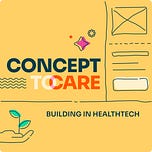Jennifer Rabiner is the Chief Product Officer at Pearl Health, where she leads the development of innovative technology solutions that empower primary care practices to excel in value-based care models like ACO REACH. With over 20 years of experience in healthcare, Jennifer has a rich background in both the health system and independent provider segments, as well as direct primary care. Before joining Pearl Health, Jennifer served as a product leader at Hint Health and athenahealth, focusing on value-based care. Her expertise also includes healthcare revenue cycle optimization and system implementation at Deloitte Consulting and Triage Consulting Group, as well as pharmaceutical reimbursement strategy at Millennium Pharmaceuticals. In addition to her role at Pearl Health, Jennifer is an advisor to several health tech startups, where she lends her extensive knowledge in product development and healthcare innovation. In our conversation, Jennifer shares insights on:
Transforming Healthcare Payment Models: Jennifer discusses the shift from fee-for-service to value-based care, highlighting the introduction of ACO REACH.
Company Growth: Pearl Health’s evolution from supporting small practices to partnering with larger physician groups and health systems, driving product innovation and integration.
Driving Engagement: Strategies to enhance engagement for both patients and providers, focusing on action-oriented and patient-centric design.
Key Features of Value-Based Care Products: The importance of patient risk stratification, real-time data, workflow integration, and goal setting.
Leveraging Diverse Data Sources: The role of claims, clinical data, and social determinants of health in supporting value-based care.
AI in Healthcare: The role of AI in enhancing clinical decision-making, supporting providers, and maintaining ethical and transparent practices.
Building in a Capitated Environment: Approaching product development with a dual thesis, focusing on outcomes, iterative development, and usability.
Integrating Customer Success: The strategic integration of customer success into product development for continuous evolution based on user feedback.
Future Plans for Pearl Health: Expanding the number of lives covered, entering new markets like Medicare Advantage, and scaling the platform for broader impact.
Jennifer’s insights highlight the strategic role of technology in healthcare and the importance of aligning product development with real-world provider and patient needs. Her approach underscores the transformative potential of data-driven, user-centered solutions in advancing value-based care and driving innovation across the healthcare landscape.
Some takeaways:
Transforming Healthcare Payment Models:
Shift from Fee-for-Service to Value-Based Care: The traditional fee-for-service model, which rewards volume, is being replaced by value-based care, which emphasizes patient outcomes and cost control. This shift aims to improve health while reducing unnecessary services.
Challenges of Implementing Value-Based Care: Transitioning to value-based care is complex, requiring providers to align incentives with patient outcomes. This shift often demands significant changes in workflows, technology adoption, and care management practices.
Introduction of ACO REACH Model: The ACO REACH model focuses on proactive, preventative care, rewarding providers for keeping patients healthy and managing chronic conditions. It also emphasizes equity in healthcare access, addressing disparities and promoting long-term health outcomes.
Financial and Operational Impacts: Moving to value-based care involves financial and operational changes, such as adopting capitation payments and new technologies. Providers must focus on effective resource allocation and collaboration to succeed in this model.
Pearl Health’s Mission and Solutions:
Pearl Health is a healthcare technology company focused on helping primary care practices transition to value-based care models like ACO REACH. By addressing inefficiencies in the traditional fee-for-service model, Pearl Health incentivizes proactive care that reduces unnecessary medical utilization, improves patient outcomes, and lowers costs. Their platform simplifies complex data, providing actionable insights that help providers efficiently manage high-risk patients and deliver better care.
Growth of Pearl Health's Footprint and Product:
Initial Focus on Small Practices: Pearl Health started by targeting small, independent primary care practices across the U.S., helping them stabilize revenue and improve patient outcomes during the financial challenges of the COVID-19 pandemic.
Attracting Larger Physician Groups: Success with smaller practices led to the expansion into larger physician groups, such as IPAs, IDNs, CINs, and MSOs, requiring enhancements to the product to handle more complex organizational needs.
Engaging Regional and National Health Systems: Pearl Health further expanded by partnering with regional and national health systems, adapting its product to support larger entities with more sophisticated coordination and management tools.
Product Evolution and Integration: To support growth, Pearl Health integrated advanced data sources and improved its predictive analytics, making the product more scalable and adaptable for a wide range of healthcare organizations, including new programs like Medicare Advantage.
Broadening Impact Across the U.S.: Strategic growth enabled Pearl Health to expand its footprint to 43 states, allowing a diverse range of healthcare providers to enhance patient outcomes and reduce healthcare costs nationwide.
Key Differences of ACO REACH Model:
Capitated Payment Model: Jennifer Rabiner highlights that one of the most significant differences in the ACO REACH model is the shift to a capitated payment structure. Unlike traditional fee-for-service models, where providers are paid per service rendered, ACO REACH gradually transitions providers to a capitated model. This means providers receive a fixed monthly payment per patient, regardless of the number of services provided. The transition to capitation begins with a small percentage and increases over time, reaching full capitation. This approach incentivizes proactive care and financial stability for providers, as they focus on keeping patients healthy rather than maximizing service volume.
Simplified Quality Measures: ACO REACH also simplifies the quality measurement process compared to previous models. Instead of managing numerous quality metrics, ACO REACH focuses on just three clinical quality measures and one patient satisfaction measure. These measures primarily track the prevention of hospitalizations, reflecting overall patient health and the effectiveness of care management. By reducing the reporting burden and focusing on key outcomes, ACO REACH allows providers to concentrate on delivering high-quality care without being overwhelmed by administrative tasks.
Driving Engagement for Both Patients and Providers:
Action-Oriented Engagement: Pearl Health’s product is designed to help providers quickly identify and address urgent patient needs, ensuring that engagement with the product leads to meaningful actions that directly benefit patient outcomes.
Earning Engagement: Recognizing that their platform operates alongside existing EMR systems, Pearl Health focuses on making their product easy to use, seamlessly integrated, and clearly valuable to providers, thereby naturally encouraging regular engagement.
Patient-Centric Design: The product is built on the principle that there is always a “right next thing” to do for every patient. This design ensures providers feel confident and proud of the care they are delivering, fostering consistent and meaningful engagement with the product.
Engaging Providers for Active Participation in ACO REACH:
Personalized Engagement Strategies: Jennifer explained that engaging providers in ACO REACH requires understanding their unique needs. Pearl Health tailors its approach by offering customized training and support, ensuring the platform fits seamlessly into each practice's workflow.
Support During and Between Appointments: Pearl Health’s platform aids providers during appointments by facilitating real-time decision-making at the point of care. Pearl Health enables providers to access Pearl Health’s Conditions to Review feature in the EHR. Pearl Health is able to expose this feature in the provider’s respective EMR through a partnership with a middleware platform called Vim.
Embedding Good Behaviors in Product Design: The platform is designed to encourage behaviors that lead to better outcomes by setting clear, achievable goals that guide providers toward actions that improve patient care and reduce costs.
Demonstrating Value Through Data: To motivate participation, Pearl Health provides data-driven insights that show how provider actions impact patient care and cost savings, helping users see the direct benefits of their efforts.
Ongoing Support and Feedback: Continuous support through regular check-ins and feedback ensures the platform evolves with providers' needs, reinforcing the behaviors and goals that drive success in the ACO REACH model.
Key Features for Building a Value-Based Care Product:
Patient Risk Stratification: Essential for identifying high-risk patients and prioritizing their care, helping providers focus on those who need the most attention to improve outcomes.
Real-Time Data and Insights: Provides actionable information during patient interactions, enabling informed decision-making and proactive management of chronic conditions.
Workflow Integration: The product must seamlessly fit into existing healthcare workflows, reducing administrative burdens and ensuring consistent usage.
Support for In-App and Out-of-App Engagement: The product should aid providers both during and between appointments to manage ongoing patient care and ensure follow-up tasks are completed.
Data-Driven Decision Making: Offers insights that demonstrate the impact of provider actions on patient outcomes and healthcare costs, guiding better practices.
Customization and Flexibility: Adapts to the specific needs of different practices, with customizable dashboards, alerts, and reports that help providers focus on what matters most.
Goal Setting and Behavioral Nudges: Encourages best practices by helping providers set clear, achievable goals and including features that nudge them towards actions that improve patient care and reduce costs.
Importance of Data in Value-Based Care: Jennifer emphasizes the critical role of diverse data sources in driving value-based care.
Total Cost of Care Claims Data: Used to track and analyze overall medical expenditures. Pearl Health leverages this data to identify cost trends, opportunities to reduce unnecessary utilization, and assess patient outcomes.
Admission, Discharge, Transfer (ADT) Data: Enables real-time monitoring of patient transitions, helping to prevent hospital readmissions by ensuring timely follow-up care.
Clinical Data: Provides detailed insights into patient health, allowing for more effective management of chronic conditions and personalized care plans.
Social Determinants of Health (SDOH) Data: Helps identify non-clinical factors affecting health, such as access to food and transportation, to offer additional support services.
Medication Fill Data: Tracks prescription adherence, reducing the risk of complications from non-compliance with treatments.
Appointment Data: Ensures high-risk patients receive timely care, particularly when predictive models indicate a likelihood of emergency room visits.
CMS’s Beneficiary Claims Data: Pearl Health is also working on reducing the latency of claims data by using more real-time sources like the CMS’s Beneficiary Claims Data API (BCDA). By integrating these various data sources, Pearl Health enhances its predictive analytics, enabling more proactive and effective care management.
Building from Zero to One in a Capitated Environment:
Thesis-Driven Development: Jennifer highlighted the importance of a dual thesis approach: a market thesis that foresees value-based care as the future, and a tech thesis that uses technology to enhance care delivery. These guide the entire development process.
Focus on Outcomes Over Features: In a capitated environment, the priority is on driving outcomes that lower healthcare costs and improve patient care, rather than simply adding features. This outcome-driven approach ensures that the product directly supports the financial and clinical goals inherent in capitated care models.
Iterative Development and Close Feedback Loops: Jennifer emphasized the importance of building iteratively, with continuous feedback from users (providers) to refine and improve the product. This approach ensures that the product evolves to meet the real-world needs of providers, where every decision can have a significant impact on patient outcomes and costs.
Simplicity and Usability: Given the inherent complexity of capitated care, the product must be simple and intuitive to use. Jennifer stressed that the product design should integrate seamlessly into providers' workflows, minimizing the learning curve and administrative burden while maximizing its impact on patient care and cost reduction.
Customer Success Integration with Product Development: At Pearl Health, Customer Success Rolls Up into Product. This structure creates a seamless feedback loop, ensuring the product evolves based on real-world user needs.
Close Feedback Loops: Integration allows the product team to quickly respond to user challenges, ensuring continuous product evolution.
User-Centered Improvements: Aligning customer success with product development prioritizes changes driven by user feedback, enhancing provider satisfaction and patient outcomes.
Proactive Problem-Solving: This structure enables the product team to identify and address issues early, improving user experience and the product’s effectiveness in delivering value-based care.
Future Directions for Pearl Health:
Expansion of Lives Covered: Pearl Health plans to significantly increase the number of lives under its value-based care models, scaling operations to reach more patients and providers across the U.S.
Entering New Markets: The company is set to expand into new markets, including Medicare Advantage, applying their value-based care approach to a broader range of healthcare models and populations.
Product Enhancements: Pearl Health is focusing on making their platform more adaptable and scalable, enhancing it to support a wider variety of healthcare providers and organizations, including larger and more complex systems.
Vertical and Horizontal Scaling: Pearl Health aims to deepen its impact within existing markets while also expanding into new areas of healthcare, ensuring their value-based care approach continues to grow and evolve.
—
Where to find Jennifer Rabiner:
Pearl Health: https://pearlhealth.com/
—
Where to find Angela and Omar:
Angela Suthrave
Omar Mousa
—
Referenced:
Pearl Health: https://pearlhealth.com/
Keep up with Pearl Health by following their Blog: https://pearlhealth.com/blog/
Athenahealth: https://www.athenahealth.com/
Hint Health: https://www.hint.com/
Value Based Care Explained: https://www.cms.gov/priorities/innovation/key-concepts/value-based-care
ACO Reach Explained: https://www.cms.gov/priorities/innovation/innovation-models/aco-reach
Pearl Health’s EMR Integration partner, VIM: https://getvim.com/
Athenahealth Population Health Solution: https://www.athenahealth.com/solutions/population-health
One of Jennifer’s favorite books, Melissa Perri - Escaping the Build Trap: How Effective Product Management Creates Real Value: https://www.amazon.com/Escaping-Build-Trap-Effective-Management/dp/149197379X
Jennifer’s favorite productivity tool: https://clickup.com/
Denver’s StartUp Week, Outcomes Based Roadmap Presentation: https://www.slideshare.net/slideshow/denver-startup-week-outcome-based-roadmaps/251218296
What is Direct Primary Care: https://www.elationhealth.com/resources/blogs/what-is-direct-primary-care
—
Check out our website: https://www.concepttocare.com
Follow us and Subscribe wherever you get your podcast:















Share this post